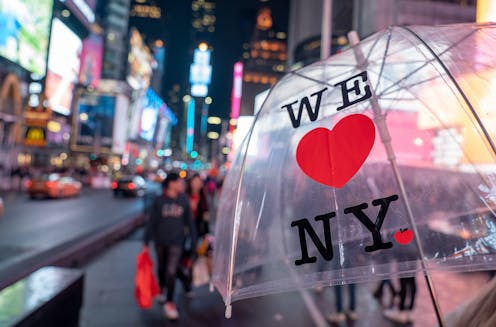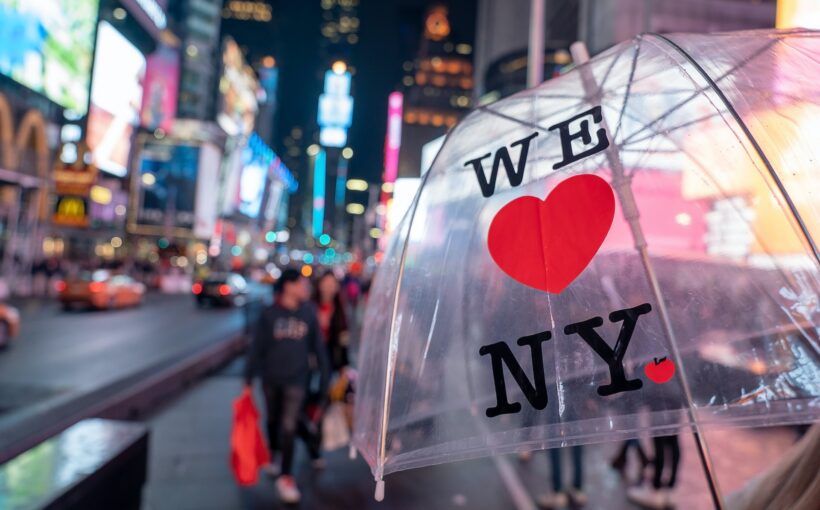
The I ♥ NY logo was launched in the 1970s when New York City was at its grittiest and most dangerous. Since then graphic designer Milton Glaser’s creation has been emblazoned on every kind of souvenir imaginable, not to mention inspiring movies, clothing, graffiti and even food.
More than 50 years later, New York has just updated its iconic branding – not for the first time – to say We ♥ NY as part of an attempt to revitalise the city after COVID lockdowns.
And while lots of people hate the rebrand, it still reflects the intent behind the much-loved original logo. These days it’s hard to argue that the brand hasn’t done the job of communicating exactly how New Yorkers – and many tourists – feel about the city.
Indeed, unlike the kind of brand advertising created for a product, this campaign was never designed to sell anything, but to communicate a feeling about the city by its people. And if people feel more positive about a city or an area, they will be more ready to help improve it.
Such campaigns are developed as part of a branding process used to whip up feelings about a place. These so-called “place branding” efforts can gather communities around whichever ideas matter most to these people, whether they are social, economic, or even environmental.
Developing a place brand can be complex and challenging, but also immensely rewarding. It can involve government, companies and society in general. It can include events, ideas and investments focused on winning over visitors, residents and investors – all to help social community and local businesses thrive and grow.
People Make Glasgow is an example of a flexible place brand that can be associated with a wide range of assets and activities. But this kind of brand doesn’t have to convey a straight, positive message about an area, town or city, it can also be connected to specific challenges.

More recent attempts at branding a location have aimed to galvanise communities to work together to create and communicate a shared identity – not just right now, but also in the future. In many cases, this includes highlighting challenges such as the impact of climate change.
Using branding to inspire support
As climate change increasingly affects areas in different ways, communities are starting to use place branding to help address specific environmental challenges. This makes sense since people tend to be attached to where they live, and communities often seek ways to act locally to work against or mitigate the effects of climate change.
Inspired by Iceland is a good example of this. The country launched a “premium tap water” brand in 2019 to encourage residents and visitors to go plastic-free while in Iceland by drinking its tap water.
Integrating climate-related issues into the branding process communicates to everyone – including tourists, investors, residents and public and private sector bodies – that climate action is a priority. It shows that it’s integral to local identity and discourse, as residents seek to protect their home’s environmental features.
Place branding may also affect local or even national government policy making. This is what happened in Palau, a Micronesian island in the western Pacific. In 2017 its government started to require all visitors to sign a pledge to be “ecologically and culturally responsible” before they could set foot in the country.
The Faroe Islands in the north Atlantic, took a slightly different approach in 2019 by declaring itself “closed for maintenance, open for voluntourism”. This initiative was used by islanders and local businesses to promote community cohesion. It also offers tourists a unique chance to connect with the core values of the country.
Adapting to new challenges
Most places are limited in their ability to adapt to challenges such as climate change. Unlike residents, local businesses and tourists, a city or country can’t relocate itself. Instead, an area must adapt, which can become a multifaceted and politically challenging process simply due to the range of people and organisations involved. Diverse community needs and imbalances of power held by public and private sector organisations only add to the challenge.
In reality, even though place branding is very much about community cohesion, diverse communities are not necessarily equally involved in the decision-making process. It’s important to recognise that initiatives – whether national, regional, or local – can only go so far, and policy-led change is also required, especially when dealing with challenges such as environmental degradation.
Place branding has become a useful tool to accompany such policies. People can also become quite attached to these brands. Indeed, rather than any reluctance to help the city face new challenges, the opposition to the We ♥ NY update shows the strength of feeling for the city and perhaps even for its brand.
![]()
Sonya Hanna receives funding through the Bangor University Innovation and Impact Award, respectively for projects titled: 'Lucozade and Litter: how can we prevent single-use plastic pollution' and 'Capitalising on the Slate Landscape UNESCO World Heritage Site and the Development of Sustainable and Regenerative Tourism in Northwest Wales'..
Thora Tenbrink works for Bangor University and currently receives funding through the Bangor University Innovation and Impact Award, by SellSTEM MSCA ITN Project No. 956124, and by the UKRI-funded RECLAIM Network Plus grant (EP/W034034/1).



